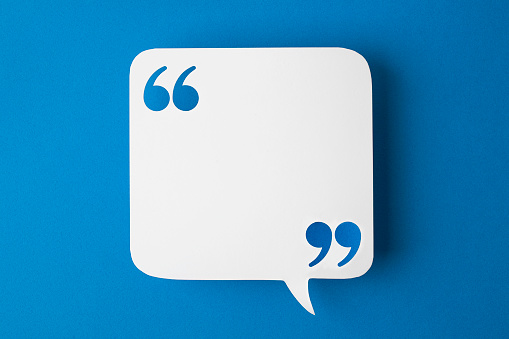| Punctuation is our favorite topic, right? Well… maybe not. Nevertheless, we writers need to master the ins and outs of punctuation if we wish to master our craft. So, in the spirit of learning good punctuation, we’ll be examining punctuation puzzles over the course of our next few Writers’ Guild newsletters. And since punctuation in the English language is quite detailed, we are going to try to keep the subject as straightforward as possible by addressing one punctuation mark at a time. We begin with quotation marks. Quotation marks work in pairs. They can indicate direct quotations, such as in fiction dialogue or in quoting verbatim from a source. Quotation marks have other uses also, but for now we are going to stick with their most common uses. We punctuate with quotation marks like this: Sally said, “Isn’t that a glorious sunset.” “Isn’t that a glorious sunset,” Sally exclaimed. Sally barked at her team to “close your open quotes this month as if your mortgage payments depend on it.” Note the commas after “said” and “sunset” in 1 and 2. Both “Sally said” and “Sally exclaimed” are attributions. They directly attribute the quoted statements to Sally. Attributions are set off by commas from quoted material. In contrast, note the lack of a comma after “to” in 3. In this case, rather than a direct attribution, the quoted material is part of a clause beginning with “to.” Therefore, a comma is not required after “to.” Note also from the examples above that commas and periods at the ends of sentences or phrases always precede punctuation marks. Quotation marks always enclose commas and periods, even if the quoted material is a fragment of a sentence, a phrase, or even a single word such as the “to” in the paragraph above. Here is another example of this punctuation rule: Despite having been rained out for three days straight, the foreman told his crew to have the house under roof by Monday or “don’t bother showing up for work.” When it comes to where exclamation marks and question marks go in relation to quotation marks, it depends. According to Jane Casagrande in The Best Punctuation Book, Period, a question mark or an exclamation mark “may come before or after a closing quotation mark, depending on whether it modifies the whole sentence or only the quoted portion.” For example: She can’t even spell “cat”! (The exclamation mark modifies the whole sentence.) Exasperated, he asked, “What do you think you’re doing?” (The question mark modifies the quoted question only, not the entire sentence.) According to Casagrande, “Quotation marks are also used to highlight words and call them into question, for example, when casting doubt, or using irony, or pointing out that a word itself is being referred to. Quotation marks also surround titles of certain works, such as movie titles in news style and article titles in book style.” Below are some examples. Highlighting certain words in a sentence: Are you sure you spelled “colleague” correctly? Reference to a movie title: Freddy watched “Jaws” six times! Quoting an article or chapter title: Please read chapter 22, “Find a Writing Buddy,” in Everybody Writes. So, as you can see from the paragraph above the use of quotation marks can take writers deep into the punctuation weeds. Just remember that when you find yourself puzzling over how to use quotation marks, Google can be your friend. Research the issue in question online. Take a couple of minutes to drill down with pointed questions. Most likely, you will find the answer. Better yet, secure a top-quality punctuation reference book, such as the Casagrande book linked below. It is excellent. Buy it in paperback, keep it handy, and mostly importantly… use it. |
Using Quotation Marks Correctly


0 Comments